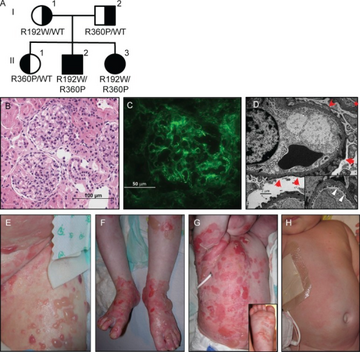ZAP70 deficiency
| ZAP70 deficiency | |
|---|---|
| Other names: ZAP70 deficient SCID | |
 | |
| ZAP70 deficiency has an autosomal recessive pattern of inheritance. | |
ZAP70 deficiency, or ZAP70 deficient SCID,[1] is a rare autosomal recessive form of severe combined immunodeficiency (SCID) resulting in a lack of CD8+ T cells.[2] People with this disease lack the capability to fight infections, and it is fatal if untreated.
It is cause by a mutation in the ZAP70 gene.
Symptom and signs

Children with this condition typically present with infections and skin rashes.[3]
Unlike many forms of SCID, absolute lymphocyte count is normal and thymus is present.[citation needed]
The clinical presentation of this condition is:[4]
- Chronic oral thrush
- Recurrent gastrointestinal infections
- Eosinophilia
- Hepatosplenomegaly
- Lymphadenitis
- Swollen lymph nodes
- Recurrent bacterial skin infect
- Skin rash
- Stroke
- Recurrent opportunistic infection
- Stomatitis
Cause
ZAP70 deficiency SCID is caused by a mutation is the ZAP70 gene, which is involved in the development of T cells.[3]
Diagnosis
It is characterized by a lack of CD8+ T cells and the presence of circulating CD4+ T cells which are unresponsive to T-cell receptor (TCR)-mediated stimuli.[5] Diagnosis is usually made within the first six months of life. Genetic testing is required.[3]
Treatment
Hematopoietic stem cell transplantation is the only known cure for ZAP70 deficient SCID.[6]
Epidemiology
ZAP70 deficiency SCID is estimated to occur in approximately 1 in 50,000 people. Fewer than fifty people with this condition have been identified.[3]
References
- ↑ Online Mendelian Inheritance in Man (OMIM): 176947
- ↑ Otsu M, Steinberg M, Ferrand C, et al. (2002). "Reconstitution of lymphoid development and function in ZAP-70-deficient mice following gene transfer into bone marrow cells". Blood. 100 (4): 1248–56. doi:10.1182/blood-2002-01-0247. PMID 12149205.
{{cite journal}}: CS1 maint: url-status (link) - ↑ 3.0 3.1 3.2 3.3 Reference, Genetics Home. "ZAP70-related severe combined immunodeficiency". Genetics Home Reference. Archived from the original on 2020-10-01. Retrieved 2020-10-19.
- ↑ "ZAP-70 deficiency | Genetic and Rare Diseases Information Center (GARD) – an NCATS Program". rarediseases.info.nih.gov. Archived from the original on 11 April 2021. Retrieved 18 August 2021.
- ↑ ZAP-70 Deficiency at Merck Manual of Diagnosis and Therapy Professional Edition
- ↑ "UpToDate". www.uptodate.com. Archived from the original on 2018-07-11. Retrieved 2020-10-19.
Further reading
- GeneReviews/NCBI/NIH/UW entry on ZAP70-Related Severe Combined Immunodeficiency Archived 2010-06-12 at the Wayback Machine
- ZAP70 deficiency; Selective T-cell defect; Zeta-associated-protein 70 deficiency at NIH's Office of Rare Diseases
External links
| Classification | |
|---|---|
| External resources |